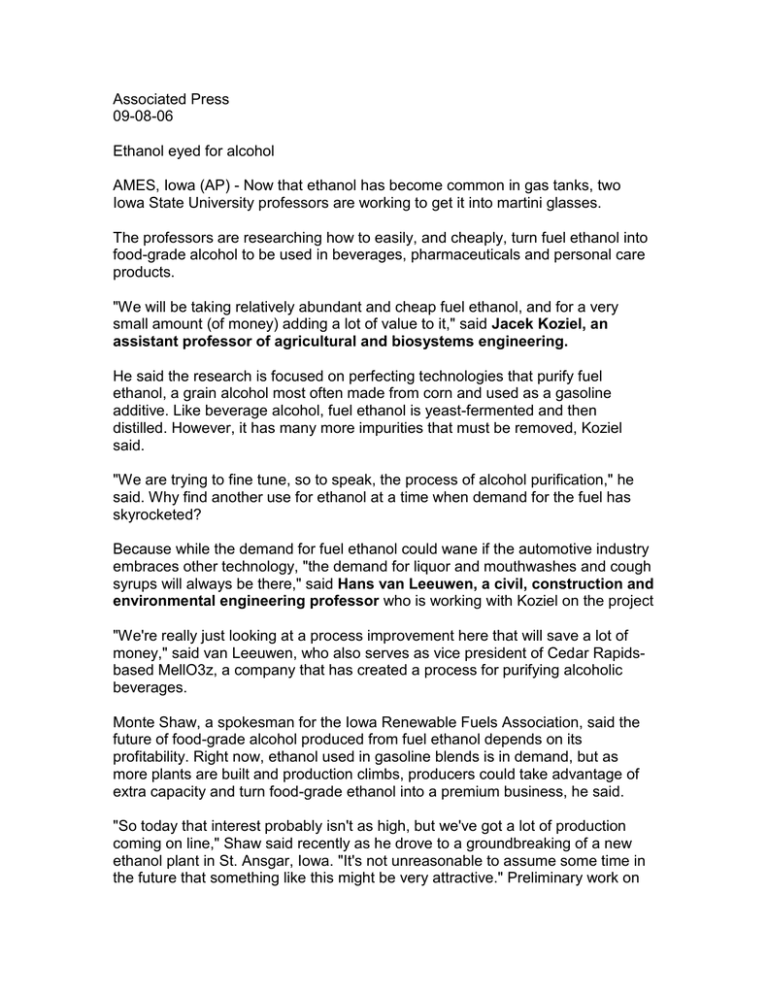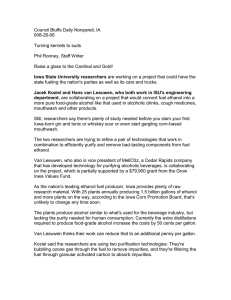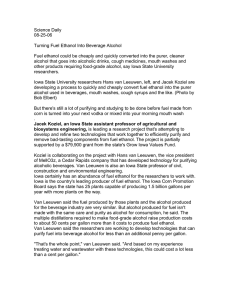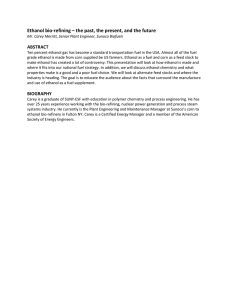Associated Press 09-08-06 Ethanol eyed for alcohol
advertisement

Associated Press 09-08-06 Ethanol eyed for alcohol AMES, Iowa (AP) - Now that ethanol has become common in gas tanks, two Iowa State University professors are working to get it into martini glasses. The professors are researching how to easily, and cheaply, turn fuel ethanol into food-grade alcohol to be used in beverages, pharmaceuticals and personal care products. "We will be taking relatively abundant and cheap fuel ethanol, and for a very small amount (of money) adding a lot of value to it," said Jacek Koziel, an assistant professor of agricultural and biosystems engineering. He said the research is focused on perfecting technologies that purify fuel ethanol, a grain alcohol most often made from corn and used as a gasoline additive. Like beverage alcohol, fuel ethanol is yeast-fermented and then distilled. However, it has many more impurities that must be removed, Koziel said. "We are trying to fine tune, so to speak, the process of alcohol purification," he said. Why find another use for ethanol at a time when demand for the fuel has skyrocketed? Because while the demand for fuel ethanol could wane if the automotive industry embraces other technology, "the demand for liquor and mouthwashes and cough syrups will always be there," said Hans van Leeuwen, a civil, construction and environmental engineering professor who is working with Koziel on the project "We're really just looking at a process improvement here that will save a lot of money," said van Leeuwen, who also serves as vice president of Cedar Rapidsbased MellO3z, a company that has created a process for purifying alcoholic beverages. Monte Shaw, a spokesman for the Iowa Renewable Fuels Association, said the future of food-grade alcohol produced from fuel ethanol depends on its profitability. Right now, ethanol used in gasoline blends is in demand, but as more plants are built and production climbs, producers could take advantage of extra capacity and turn food-grade ethanol into a premium business, he said. "So today that interest probably isn't as high, but we've got a lot of production coming on line," Shaw said recently as he drove to a groundbreaking of a new ethanol plant in St. Ansgar, Iowa. "It's not unreasonable to assume some time in the future that something like this might be very attractive." Preliminary work on the effort began last year, and the 1 1/2-year project - which uses ozone gas and a carbon filtration process - was recently launched. Funding comes from a $79,900 grant from the state's Grow Iowa Values Fund, with matching dollars and materials from industry sponsors and experts. Iowa, the nation's top corn grower, has become a leader in the ethanol industry with 25 plants producing about 1.6 billion gallons this year and another eight plants under construction or expansion, according to the Iowa Renewable Fuels Association. The key to the effort is price. Van Leeuwen said the multiple distillations needed to make food-grade alcohol raise production costs by about 50 cents per gallon more than it costs to make ethanol. The system the ISU team is working on aims to put purifying costs at less than a penny per gallon, he said, adding that retrofitting the purification process would cost little for ethanol plants. "It's the type of thing that will pay for itself over and over within a year," van Leeuwen said. Koziel said there are many potential applications for the product. "It's not just necessarily the consumer of liquor-type alcohol" who benefits, he said. "It could be used for all sorts of other consumer products ... everywhere where food-grade alcohol could be put to use." But for those who like their liquor, van Leeuwen said the food-grade ethanol "tastes just like vodka," although the 190-proof product must be diluted. He said he's hosted one tasting panel with positive results, and plans another after further research. The ISU scientists are using two purification technologies for their system. The first part involves bubbling ozone gas through the fuel ethanol to remove impurities and to form new compounds, which are then filtered through granularactivated carbon to absorb remaining impurities. A patent for the process is pending. Van Leeuwen said he's used the process to treat wastewater with success, and expects fine results for food-grade alcohol. "I have little doubt that it will work," he said.





